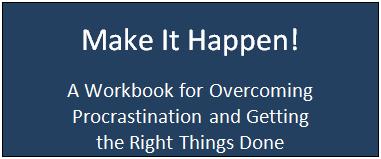 “Do we have a shortage of time? No, we don’t. Time is the medium in which we exist. To complain about a shortage of time is like a fish in the sea complaining that it has a shortage of water.” — Mark Forster
“Do we have a shortage of time? No, we don’t. Time is the medium in which we exist. To complain about a shortage of time is like a fish in the sea complaining that it has a shortage of water.” — Mark Forster
Mark Forster is an internationally recognized time-management expert. In his book, “Do It Tomorrow and Other Secrets of Time Management”, he teaches us how to get things done by–among other things– “doing it tomorrow”. In this blog post you’ll discover several of the time management strategies and techniques which Forster recommends.
Three Possible Causes of Time Problems
Forster explains that there are only three possible causes of time problems. These are the following:
- You’re working inefficiently.
- You have too much work to do.
- You have too little time in which to do your work.
Forster than goes on to explain why none of these are time problems; instead, they’re problems in how you’re managing yourself.
The first reason that you may not have enough time to do what needs to be done is that you’re working inefficiently. That is, you’re working in a distracted, unfocused, and fragmented way. Your problem, then, is not time, but your work habits. Although you can’t create more time, you can improve your work habits.
The second reason that you may be complaining about a lack of time is that you have too much to do. Work comes from the commitments that you’ve taken on. If you have too much on your plate, then you’ve taken on more commitments than you can handle. The solution to this is two-fold:
- Go through your commitments and eliminate those which are not a priority for you.
- Before you take on a new commitment you need to understand that you’re going to have to make time for it by letting go of a previous commitment.
The third reason that you may feel that time is a problem for you is that you keep telling yourself that you don’t have enough time. Not having enough time is about over-scheduling. That is, it’s about the following:
- Failing to take into account things such as travel time;
- Underestimating how long it will take you to complete a task;
- Leaving out steps that you must take in order to complete a project, and so on.
When you decide how many commitments to take on, you have to make sure that you’re being realistic about how much time it’s going to take you to fulfill each commitment.
Seven Principles of Good Time Management
Forster then goes on to explain the following seven principles of time management:
- Have a clear vision to bring clarity and focus to everything you do. Your vision allows you to decide what to do, as much as it helps you to decide what not to do. That is, your vision will allow you to decide which commitments to take on and which commitments to say “no” to.
- Do one thing at a time. Establishing limits is an important way to get things done, and one essential limit is to do one thing at a time. Forster explains that most unsuccessful people don’t sit around doing nothing all day; instead, they try to do so many things at once that they never get anything done. It’s much more effective to focus on one task, and when you’re done, move on to the next.
- Little and often. It is more effective to exercise five times a week for half an hour each day than it is to do nothing for two weeks and then exercise for four hours. At the same time, it’s more effective to work on a report for a couple of hours each day than it is to leave it all for the weekend before it’s due.
- Define your limits. We’ve already discussed setting the limit of doing one thing at a time. Another limit is to work on clearly defined goals with clearly defined boundaries. Still another is to give yourself a definite period of time in which to complete tasks instead of leaving it open-ended. There are many ways in which you can set limits to make sure that you get things done.
- Create closed lists. A closed list is any list that has a line drawn on the bottom so that nothing more can be added to it. For example, your to-do list for the day should be a closed list. Once you’ve created your to-do list for the day, don’t add anything new to it. If something new comes in during the day, unless it must be done immediately or there will be a significant downside, leave it for another day.
- Reduce random factors. Interruptions, or random factors, are the main reason why people don’t complete their work during the day. Although you can’t get rid of all random factors, the goal is to eliminate as many of them as possible.
- Commitment v. Interest. Forster explains that there’s no limit to the amount of things that you can be interested in. However, nothing much is likely to come out of an interest unless it turns into a commitment. Go through the things that you’re interested in doing and identify which of those rise to the level of commitments.
Conclusion
Foster’s basic message is that while there isn’t enough time to do it all, there is more than enough time to do those things that are most important to you. In addition, one of the best ways to get things done is by setting limits:
- Set limits on the amount of commitments that you take on;
- Do one thing at a time;
- Create closed lists;
- Limit interruptions; and so on.
Follow the tips above and get started taking the necessary steps in order to live your best life.

Related Posts:
1. Time Investment: Invest Your Time Instead of Spending It
2. 18 Powerful Tips for Overcoming Procrastination
3. Stop Procrastinating Tip: Practice Discomfort
4. The One-Hour-A-Day Formula
5. How to Live a “Hell, Yeah!” Life
Did you enjoy this article? Subscribe to “Daring to Live Fully” by clicking here and get free updates.







 Marelisa Fabrega is a lawyer and entrepreneur. She holds a Bachelor of Science in Business Administration from Georgetown University in Washington, D.C., as well as a Juris Doctor from the Georgetown University Law Center. You can learn more about her
Marelisa Fabrega is a lawyer and entrepreneur. She holds a Bachelor of Science in Business Administration from Georgetown University in Washington, D.C., as well as a Juris Doctor from the Georgetown University Law Center. You can learn more about her 






Comments on this entry are closed.
Hi,
nice reading!